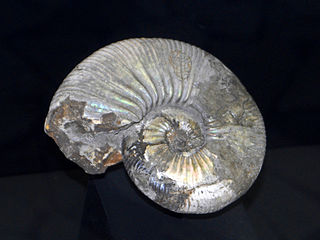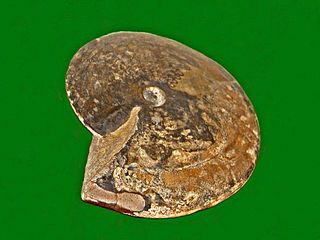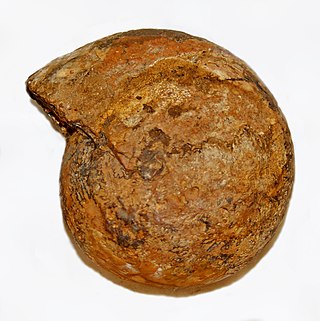Related Research Articles

Ammonoids are extinct spiral shelled cephalopods comprising the subclass Ammonoidea. They are more closely related to living coleoids than they are to shelled nautiloids. The earliest ammonoids appeared during the Devonian, with the last species vanishing during or soon after the Cretaceous–Paleogene extinction event. They are often called ammonites, which is most frequently used for members of the order Ammonitida, the only remaining group of ammonoids from the Jurassic up until their extinction.

Ammonitida or "True ammonites" are an order of ammonoid cephalopods that lived from the Jurassic through Paleocene time periods, commonly with intricate ammonitic sutures.

Acanthohoplites is an extinct genus of ammonites in the family Parahoplitidae that lived in the Aptian and Early Albian stages of the Early Cretaceous.

Audaxlytoceras is an extinct genus of lytoceratid ammonites.

Highway 13 is a highway in the Canadian province of Saskatchewan. It runs from the Alberta border until it transitions into Highway 2 at the Manitoba border near Antler. Highway 13 is about 676 km (420 mi.) long. Highway 13 passes through Shaunavon, Assiniboia, Weyburn, Redvers and Carlyle. It is also referred to as the Red Coat Trail, as much of its length follows the route of the original historic path. A majority of the route between Wauchope and Govenlock going through the Palliser's Triangle is also referred to as the Ghost Town Trail.

Ceratitida is an order that contains almost all ammonoid cephalopod genera from the Triassic as well as ancestral forms from the Upper Permian, the exception being the phylloceratids which gave rise to the great diversity of post-Triassic ammonites.
Adrianitidae is a family in the Adrianitaceae, a superfamily of ammonites in the cephalopod order, Goniatitida, known from the Middle Pennsylvanian to the Middle Permian.

Prolecanitida is an order of extinct ammonoid cephalopods, the major Late Paleozoic group of ammonoids alongside the order Goniatitida. Prolecanitids had narrow shells, discoidal (disc-shaped) to thinly lenticular (lens-shaped). They retained a retrochoanitic siphuncle, a simple form with septal necks extending backwards. As is typical for ammonoids, the siphuncle sits along the ventral margin of the shell.

Agoniatitida, also known as the Anarcestida, is the ancestral order within the cephalopod subclass Ammonoidea originating from bactritoid nautiloids, that lived in what would become Africa, Asia, Australia, Europe, and North America during the Devonian from about the lower boundary of Zlichovian stage into Taghanic event during upper middle Givetian, existing for approximately 25 million years.

Acanthoceratoidea, formerly Acanthocerataceae, is a superfamily of Upper Cretaceous ammonoid cephalopods belonging to the order Ammonitida, and comprising some 10 or so families.
The Danubitoidea is a large and diverse superfamily in the order Ceratitida of the Ammonoidea that combines five families removed from the Ceratitaceae, Clydonitaceae, and Ptychitaceae.
Tikisuchus is an extinct genus of rauisuchid archosauromorph. It is known from the Late Triassic Tiki Formation in the Shahdol District of central India and was the first rauisuchid to have been found in Asia. The horizon from which remains have been found is Carnian in age. The type species is T. romeri, named in honor of American paleontologist Alfred Romer. Romer was present at the Tiki locality during the excavation of the fossil, but died before the description of the genus in 1987. Tikisuchus is known only from one specimen, called ISI R 305, which consists of the skull and some postcranial elements of a young individual.

Stoycho Vassilev Breskovski was a Bulgarian paleontologist.
Sibiritidae constitutes a family of ceratitid ammonites described in the Treatise, Part L, 1957, as ribbed or tuberculate derivatives of Meekoceritidae with modification of the venter from mere widening and transverse ribbing to sulcation.

Turrilites (Turrilites) costatus is a species of helically coiled ammonoid cephalopod, from the lower part of the Upper Cretaceous (Cenomanian).

Hedenstroemiidae is an extinct family of cephalopods in the ammonoid order Ceratitida. They were nektonic carnivores.
Anniealexandria is an extinct genus of amphisbaenian lizard known by the type species Anniealexandria gansi from the earliest Eocene of Wyoming. Anniealexandria is the only known member of the family Bipedidae in the fossil record, which otherwise only includes the extant genus Bipes from Mexico. It was named in 2009 in honor of Annie Montague Alexander, founder of the University of California Museum of Paleontology. Remains of Anniealexandria are known only from a single fossil locality in the Bighorn Basin called Castle Gardens, but within the locality its fossils are common in the Willwood Formation, usually consisting of isolated jaw bones and vertebrae. Anniealexandria seems to have been a common component of a paleofauna that included fifteen other lizard species and existed in western North America during a period of global warming in the latest Paleocene and earliest Eocene.

Halorites is an extinct genus of Triassic ammonoids belonging to the family Haloritidae.
References
- Arkell, et al. Mesozoic Ammonoidea; Treatise on Invertebrate Paleontology, Part L, Ammonoidea. Geol Soc of America and Univ Kansas press, 1957, R. C. Moore (ed)
- Arctomeekoceas - Paleobiology.
- Axel Heiberg Island Paleofauna.
- Mengilyakh Creek Paleofauna